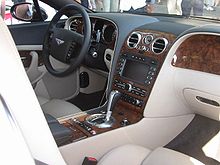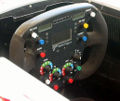Dashboard

A dashboard, dash board, or simply dash (and sometimes fascia in British English) is a control panel located under the windscreen (windshield) of an automobile. It contains indicators, dials, controls and displays to assist operation of the vehicle.
Originally, a "dashboard" was the upturned front of a horse-drawn chariot or waggon, which protected the driver from mud and debris thrown up by the horse's hooves. [1] [2]
Types of dashboards

Lawn mowers, farm tractors, and earlier automobiles sometimes have little more than a steering wheel and ignition switch.
Custom-built coupé race cars often simply have a piece of sheet metal that forms the dash. Whenever a new gauge needs to be added, a hole for the gauge is drilled in the appropriate location.
Open wheel race cars have no space for a dash, so the instrument cluster is integrated into the center of the steering wheel.
Motorcycles and mopeds have a compressed version of car dashes, but sometimes have enough room for items such as tape decks and GPS navigation.
Padded dashboards
Under the aegis of a safety program initiated by Robert McNamara[3], padded "safety" dashboards were introduced in 1956 by Ford under the name "Safeguard". Consumers showed little interest [4].
One of the safety enhancements of the 1970s was the widespread adoption of padded dashboards. The padding is polyurethane foam, while the surface is either plasticized PVC (polyvinylchloride) or leather (in luxury brands).
In the 1990s, driver's-side airbags became mandatory in some countries and passenger-side airbags became widespread.
Dashboard items

Items located on the dashboard first included the steering wheel and the instrument cluster, which by now contains gauges such as a speedometer, tachometer, odometer, and fuel gauge. Later came heating controls, lighting controls, and audio controls.
The first audio component other than a radio was a monophonic phonograph option on some Chrysler cars well before the cassette or eight-track tape players, which could only be operated when the car was stopped. Graphic equalizers and controls for increased bass came next, and finally CD players.
The audio system controls (such as radio and CD player) may also be on the dashboard, although volume and tuning, for example, may be controlled from a stalk beside the steering wheel.
The top of a dashboard may contain speakers for an audio system, and vents for the heating and air conditioning system. A glovebox is often found on the passenger side, and sometimes on both sides.
In more modern cars, automotive navigation systems are mounted in the dashboard. Increasingly, manufacturers are experimenting with moving all display portions to the centre. Various arguments are put forward for this, including cost savings when constructing both left- and right-hand-drive versions.
Instrument fashion
Vehicles concentrating on performance, whether built by race teams or by hobbyists, as well as those of minor automobile manufacturers, have always used functional instruments made by specialist firms. These are round, and typically had black faces with white marks and labels on them. They would come to be illuminated from behind, consisting of a translucent plastic face printed in black surround. Recently it has become fashionable to have the faces white and the marks black.
Cars which were to be built in forms of right-hand drive and left-hand drive sometimes put their instruments in the center of the dashboard, especially in cars with only two places in the front seat.
In the 1940s through the 1960s, American car manufacturers and their imitators designed unusually-shaped instruments on a dashboard laden with chrome and transparent plastic, which could be less readable but was often thought to be more stylish. Sunlight could cause a bright glare on the chrome, particularly for a convertible.
With the coming of the LED in consumer electronics, some manufacturers used instruments with digital readouts to make their cars appear more up to date, but this has faded from practise. And in imitation of fighter aircraft, but in a far less complex display, some cars project onto the windscreen the speed of the car.
Gallery
-
Dashboard of a WWII jeep
-
A modern Formula 1 car may have its on-board instrumentation mounted on the steering wheel
-
A cluster of gauges as typically seen on kit-cars
-
Typical dashboard position in the front of the passenger compartment
Notes
- ^ "Dictionary entry for dashboard". Merriam-Webster. Retrieved 2006-10-11.
- ^ "Puzzler Answer: Dashboard Definition". Car Talk. 2002-03-09. Retrieved 2006-10-11.
- ^ The Fog of War documentary
- ^ Iacocca: An Autobiography, chapter four




